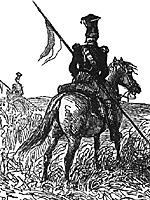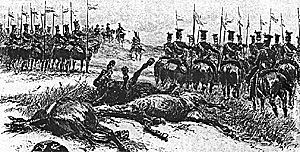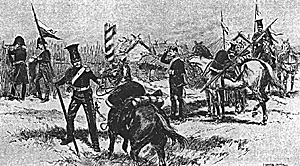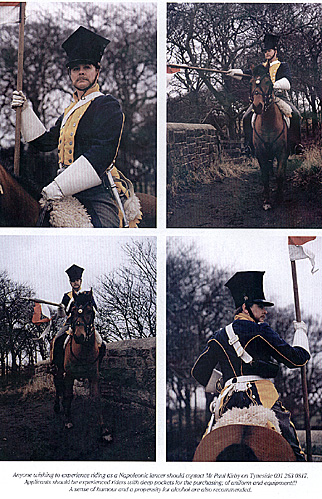 One of the few successes of Napoleon's Peninsular Campaign were the Polish Lancer Regiments. The First Vistula Lancers entered Spain in late May of 1808, the Second Regiment in 1809, both regiments being part of the Vistula Legion, which also consisted of four Polish infantry regiments (numbered one to four).
One of the few successes of Napoleon's Peninsular Campaign were the Polish Lancer Regiments. The First Vistula Lancers entered Spain in late May of 1808, the Second Regiment in 1809, both regiments being part of the Vistula Legion, which also consisted of four Polish infantry regiments (numbered one to four).
The First Vistula Lancers served under Lefebvre-Desnouettes, based in Aragon and were engaged in the fighting around Saragosa during the first seige and at Tudela in November 1808. In August 1810 the Elite company of the first regiment provided Marshal Suchet with an escort squadron.
Their finest hour came on May 16th, 1811, at the Battle of Albuera. The "Picadores" as the Spanish nicknamed them, charged against the Flank of Colbournes British Brigade and under Colonel Jan Konopka, supported by the French 2nd Hussars, crashed into the Ist Battalion of the British 3rd Regiment (the "Buffs"), the 2nd Battalion of the 48th Regiment then the 2nd Battalion of the 66th, carving the brigade to bloody ruin, and proving the usefulness of that medieval weapon, the lance.
They were aided in their slaughter by the driving and sporadic rain and hail that soaked the cartridges of the British Infantry, rendering the usually fearsome British firepower ineffective. Within five dramatic minutes three of Colborne's four battalions were torn asunder, only the 2nd Battalion of the 31st Regiment managed to form square. Of eight officers and 1,568 men only 12 officers and 378 men remained with the colours, almost half of the remainder being captured. Marshall William Carr, Viscount Beresford, in command of the Allied British, Portuguese and Spanish forces, unhorsed a lancer barehanded, by first parrying the lance with his arm, then throttling his victim and casting him to the ground to be trampled under hoof, then finally shot by one of Beresford's orderlies.
The lancers' and hussars' charge carried them into Cleve's King's German Legion battery, only one gun out of six managing to escape. Following this the charge dispersed into a series of small skirmishes, some cavalry being repulsed by the 31st's square the remainder either attempting to spur on or reform. Of those that continued, some lancers chased the Spanish General Zaya's staff into taking sanctuary in a Spanish square, General d'Espana being wounded in the scuffle. One lancer, the battle madness upon him, charged the Portuguese staff, creating mayhem, and causing several wounds upon them until being cut down. At this point the British 4th Dragoons (387 men) and a body of Spanish horse (720 men) moved to the counter attack.
 Rallying what they could of their forces the lancers and hussars advanced against them. This was enough for the Spanish cavalry, they broke before contact, streaming back to the rear, leaving the Dragoons to be overthrown, losing 27 men and having their two squadron captains taken prisoner.
Rallying what they could of their forces the lancers and hussars advanced against them. This was enough for the Spanish cavalry, they broke before contact, streaming back to the rear, leaving the Dragoons to be overthrown, losing 27 men and having their two squadron captains taken prisoner.
If Latour-Mauborg had thrown the rest of his cavalry into the gap thus created then a French victory might have rapidly ensued, but for whatever reason he did not and so a lull settled over the field. The Polish and French cavalry rounded up their prisoners, sending them and a captured howitzer to the rear. The French camp followers had apparently stolen the limber horses so the other captured artillery was abandoned. During the attack on Colbourne's brigade the lancers and hussars carried off several British standards, the first being taken by Captain Wincenty Konopka (the Colonel's brother), despite his being seriously wounded. The King's colour of the Buffs was saved by Lieutenant Matthew Latham, incurring severe wounds in the process and inspiring the painting "Battle of Albuera" by Wollen. (copies available from Cranston Fine Art Prints). The Vistula Lancers were now called upon to charge against four Portuguese battalions. These formed square, giving the lancers a disciplined fire, and throwing them back. In their last charge of the battle the Lancers attacked Cole's division, throwing Myer's Fusiliers into disorder before being repulsed again by the Portuguese.
The battle was now over for the lancers and they were formed up to help provide the rearguard for Marshal Soult's retreating forces. Colonel Konopka's Lancers had proven their worth, engaging in the most successful cavalry charge of the Peninsula campaign. The First Vistula lancers losses for Albuera were approximately 160 men out of an original complement of 59 1. The second hussars losses were 73 out of 305 men.
Transformation
In June 1811, Napoleon, realising the usefulness of the lancers, transformed the 1st, 3rd, 8th, 9th, 10th and 29th Dragoons into Lancer regiments with one stroke of his pen (and several months training). These six regiments were numbered one to six, with the Vistula Legions First and Second regiments being relegated to 7e and 8e respectively. The newly converted 30th Chasseurs were tagged onto the end as the 9e regiment.

These "new" cavalry formations were initially intended to produce light cavalry support for the heavy cavalry corps. Scouting, screening, pursuing and providing piquets, they were to be the "eyes and ears" of the heavy cavalry, the only time they were used strictly in this role was in the 1812 campaign.
In the Peninsular the mixed formation Gendarmerie units incorporated, by 1812, twenty squadrons of Lanciers Gendarmes in six legions. As well as anti guerrilla activities they fought as line cavalry, losing 831 dead and 1,078 wounded during the course of the war.
The Line Lancer regiments fought on through 1812 until being decimated in the retreat from Moscow. Always now at the cutting edge of Napoleon's campaigns, they shared the hardships with the other light cavalry.
In October 1813 Napoleon stood at bay in the area of Leipzig. The Polish Lancer regiments fought with their accustomed bravery, losing so many men that on 13th December 1813 Napoleon ordered the 7e and 8e regiments to merge, originally into a new 8e regiment, then, after protests, into a reconstituted 7e regiment, formed of three squadrons. The 8e regiment appears on some orders of battle in early 1814, therefore may not have been merged with the 7e regiment.
Upon the Emperor's fall the 7e and 8e regiments were disbanded by the Royal Ordinance of 12th May, 1814. With Napoleon's return in 1815 he attempted to raise some Polish regiments, the 7e Chevauleger-Lancier polonais were organised in Soissons and consisted of 23 officers, 327 men and 13 horses. The regiment fought on foot, defending the Sevres bridges on the outskirts of Paris in July 1815. With the restoration came final disbandment when the regiment refused to serve in the Polish army under the Russian Czar Alexander.
Both the original Lancer Regiments in the French Army (First and Second Vistula Lancers) wore the Polish Kurtka jacket. Subsequent Polish Uhlan Regiments along with their Russian, Prussian and Austrian counterparts all wore uniforms of the Polish pattern.
In the First and Second Vistula Regiments the Kurtka was a dark blue colour with all piping, cuffs, collar, turnbacks and lapels in yellow. On campaign the lapels could button over, being dark blue on the reverse. Line companies had pointed shoulder straps in dark blue, piped yellow whilst elite companies wore white epaulets on their right shoulder and white aiguilettes on the left.
A white cumberbund with two blue stripes was worn around the waist and instead of a shako, the Poles wore their traditional headwear, the czapka. The czapka appears to have been in a dark blue, almost black, with a black turban and the top piped white having a maltese cross embellished upon a French tricolour cockade as decoration on the left front of the czapka.
A white plume was worn for full dress occasions however Elite companies wore a red plume with white cords and flounders. The sunburst plate for the front of the czapka was not authorised until after the change from Ist and 2nd Vistula Lancers to 7e and 8e regiments in 1811.
After 1811 the centre companies wore a carrot shaped pompom coloured red for the Ist squadron, sky blue for the 2nd, aurora for the 3rd and violet for the 4th. Buttons remained of white metal and sword, gauntlets and cross belts were of white buff leather.
Lancer trousers comprised the "pantalons a cheval" for campaign dress in blue with black leather inserts on the inner leg. Full dress required the wearing of blue breeches with two yellow stripes down the outer legs. The 9e Regiment de Lanciers Polanaise, previously the 30th Chasseurs were issued with a Polish pattern uniform and czapka. Accounts conflict as to whether the sunburst plate was issued to this regiment. The czapka's black leather peak was bound with white metal, a regimental distinction being the full dress black plumes, tipped green. White cords were suspended from the corners of the czapka.
As with the 7e and 8e the Kurtka colour was dark blue, all cuffs, collars, lapels and piping being "Chamois" or pale yellow. Shoulder straps were dark blue piped "Chamois". An interesting point about the breeches is the reported use of red cloth instead of regulation blue, the style being of the baggy mameluke variety, especially in the case of the officers. Troopers "pantalons a cheval" had black stripes down the outer seams. The schabraque was red with a black lace strip along the edge and green with black trim portemanteau being carried on the back of the saddle. Some sources list the lance pennant of the regiment as chamoise over white or white over red. Weaponry consisted of sword, carbine, pistols and lance, the sword either the year IX pattern or the year XI pattern, these had either a single or three bar hilt for protection of the hand. The carbine was of the standard chasseur and hussar's pattern, the year IX musketoon.
A lancers prime weapon was, of course, the lance. 2.76 metres long, comprised of hardened wood, usually painted black, with a white leather strap affixed at the balance point to provide purchase for the grip, the lance was topped by a steel tip and also had a pointed butt to enable injury to be inflicted by both ends. Lance pennons were swallow tailed, red over white for the 7e and 8e.
Lancer recruits and the converted dragoon and chasseur regiments needed to practise vigorously to attain proficiency with the lance. A novice would be drilled in the lance evolutions on foot before being allowed to practice mounted. Lancers were trained to swing the lance in defensive circles and revolve it, whilst holding the centre grip and extending the right arm above the head. This being designed to keep the enemy at a safe distance, especially whilst dispersed after a charge.
The main problem faced by lancers was what to do if the enemy cavalry got past the lance point as it was difficult to inflict injury at close quarters with the lance, the lancers being left to either extend the combat distance or parry furiously with the lance shaft and in a swirling melee there would be no time to draw swords whilst enemy cavalrymen slashed wildly at their heads and bodies.
Sometimes the second rank of lancers were armed with swords to enable them to exploit the gaps created by the initial impact of the lance armed front rank. Marshal Marmont proposed to Napoleon that the front rank of every cavalry regiment be comprised of lancers to exploit this tactic. Lancers could also be deadly when pursuing enemy cavalry or infantry, their extra reach often being decisive against a fleeing foe.
At the battle of the Katzbach a Prussian infantry square stood unbroken in the teeth of French cavalry attacks. With its firepower made ineffectual due to the driving rain, the Prussians sole defence were their bayonets. This stalemate lasted until the lancers were brought forward to outreach the Prussian bayonets and prise open the square.
Another instance was at the battle of Dresden when an Austrian infantry square withstood cuirassiers until General LatourMaubourg brought up his fifty strong lancer escort and used them to lacerate the Austrian square, allowing the cuirassiers to enter and rip the square asunder.
On occasion a formed body of lancers would present a phalanx of lance points as at Genappe in 1815 when French Lancers kept British Hussars at bay simply by presenting an unbroken array of lance points across a narrow street. In the next article I will examine the 1st to 6th Line Lancers, but, for now, let the last word go to Sergeant James Anton of the 42nd Highlanders at Quatre Bras 1815,
"Of all descriptions of cavalry, certainly the lancers seem the most formidable to infantry, as the lance can be projected with considerable precision, and with deadly effect, without bringing the horse to the point of a bayonet; and it was only by the rapid and well directed fire of musketry that these formidable assailants were repulsed."

Le Chevau-Legere Lanciers Part 2 Uniforms and Regimental Histories
-
Uniforms and Horse Furniture
The First Line Lancers: Regimental History
The Second Line Lancers: Regimental History
The Third Line Lancers: Regimental History
The Fourth Line Lancers: Regimental History
The Fifth Line Lancers: Regimental History
The Sixth Line Lancers: Regimental History
Back to Napoleonic Notes and Queries #13 Table of Contents
Back to Age of Napoleon List of Issues
Back to MagWeb Master List of Magazines
© Copyright 1993 by Partizan Press.
This article appears in MagWeb (Magazine Web) on the Internet World Wide Web.
Other military history articles and gaming articles are available at http://www.magweb.com